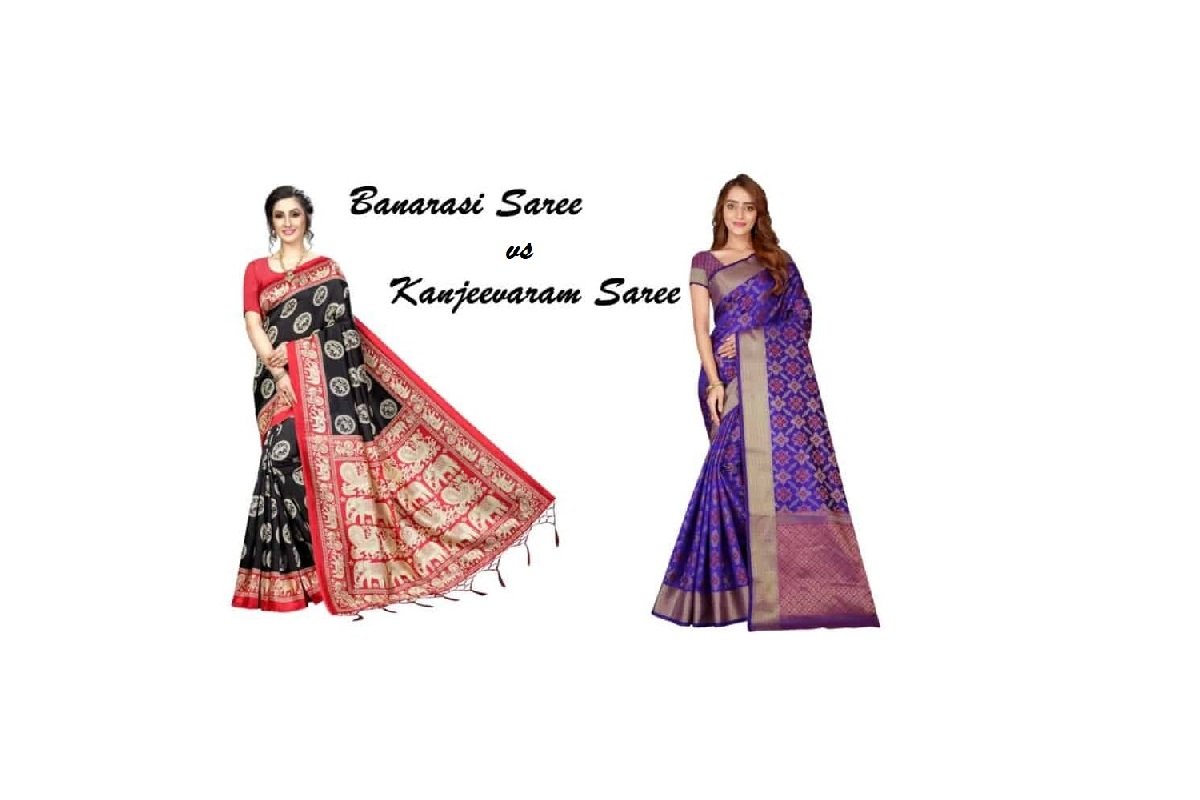Today, when I was going through the albums of some beautiful Indian weddings, the brides stole my
attention all of a sudden. More precisely, the bridal attires – a Kanjivaram saree and a Banarasi saree grabbed my eyes. The gorgeous golden threads took my heart away, and I was wondering if I should
enlighten you with the difference between the two sarees. So, here I am bringing forth all that you
require to know about the two stunning pieces of clothing.
So, what is the difference between Banarasi and Kanjivaram saree? Both are silk sarees. While
Banarasi weave originates from Varanasi, North India and Kanjivaram derive its roots from
Kancheepuram, South India. While zari work is the beauty of Banarasi sarees, in Kanjivaram
sarees, golden threads are used for intricate detailing. Beyond these, the Banarasi sarees differ
in the way of draping, styling, and there are a dozen of different types of these beautiful sarees.
Wait! While I mentioned Kancheepuram to be the origin of Kanjivaram, did you get Kanjivaram
confused with the Kanchipuram sarees? Let’s try to find an answer.
What is the difference between Kanjivaram and Kanchipuram Sarees?
Kanjivaram sarees are originated from Kancheepuram, South India. So, the Kanjivaram sarees are
sometimes referred by the name of its hometown as Kanchipuram sarees. All in all, Kanjivaram,
Kanchipuram, and Kanchi Pattu sarees are the names of a single saree.
Types of Banarasi Sarees
Now, coming back to the major discussion of how Banarasi sarees differ from Kanjivaram sarees.
Though the Banarasi sarees are renowned as gorgeous silk sarees, they are weaved from several
types of fabric and designs.
The designs in Banarasi sarees are inspired by the Mughal culture. The weavers use golden and silver
Zaris to weave the designs of flowers and motifs, called Kalga or Bel. The intricate detailing is so timetaking, that a piece of Banarasi saree takes almost fifteen days to six months to stand finished.
Katan or pure silk, contemporary Shattir, Organza, Georgette, Jangla, Butidar, Tanchoi, Cutwork, and
Tissue are the fabric choices in Banarasi brides sarees. Choose any of these royal affairs to stand out
in the crowd on your wedding day.
How to Wear a Banarasi Saree?
Gone are the days when traditional draping and accessorizing was the only option to wear a Banarasi
saree. With the modern brides getting more creative, there are a plethora of Banarasi saree bridal
looks to choose from.
The styling of Banarasi sarees differs from Kanjivaram sarees in the way that the sarees originated
from different places, and different sets of accessories complement the two sarees. So, how do you
wear and style a Banarasi saree perfectly on your marriage day?
Banarasi sarees offer you a sprinkle of Mughal grandeur. You have a lot to experiment with a Banarasi
saree wedding outfit. A variety of colour options is the major attraction of Banarasi sarees. The sarees
with a heavy border and ruffle designs on the corners make you look bulky and aged.
So, choose a design that is a mid-way between too much heavy designing and too simple designs that
ruin the gorgeousness of a Banarasi saree. You can choose any blouse from plain matching coloured
blouses, to embroidered ones, zari blouses, and matching bordered blouse, to complete your Banarasi
bridal look.
Types of Kanjivaram Sarees
Similar to the Banarasi sarees, another Shaadi wear saree, Kanjivaram sarees, is made up of several
fabrics, and decorated using distinct designs. The gorgeous Kanjivaram sarees are woven with pure
Mulberry silk, making the attire a priority choice among many Indian brides.
The Kanjivaram sarees offer a designer choice among traditional temple design, plain Kanjivaram with
gold border, and floral weave motifs. Along with these, you have an option to choose between
traditional and modern silk sarees.
How to Wear Kanjivaram Sarees?
Kanjivaram sarees are so gorgeous that it makes the saree worth wearing on a wedlock ceremony, or
a reception party by the bride. For this reason, these bridal silk sarees are even the celebs’ favourite
attires, and many famous personas were spotted wearing the attire on their D-day. If you are planning
to wear a Kanjivaram masterpiece at your wedding, you must know how to carry the beautiful attire like
a pro.
While choosing a Kanjivaram design, you must consider your feminine curves. The exclusive designs
of temples, stripes, and checks look more traditional than any other. But heavy borders and larger
designs will make you look curvier and bulky. So, such a design is most-suited to lean and slim bodytype women.
Blouses are the better half of a Kanjivaram saree, and there are some factors to consider before
choosing a matching blouse for your attire. Though a contrast colour palette between the saree and
blouse is a famous affair, going traditional with the same colour blouse as the saree is an evergreen
hit.
Also, citing a balance between saree and blouse is necessary. So, if you choose a heavy bordered or
densely designed saree, ensure that you choose a lighter blouse, with lesser work on it.
Finally, you need to accessorize to make your outfit a super hit. Carry a dense kajal eyed look, with a
bindi, traditional temple jewelry in gold, and an optionally oxidized gold waist girdle to complete your
traditional outfit.
Which Suits You Better in Your Wedding – Banarasi or Kanjivaram saree?
After knowing the elegance of these sarees, a general question comes in our mind about which saree
to wear at the wedding – Banarasi or Kanjivaram? The answer depends solely on your personal
preferences, budget, and factors like that.
1. Design
Banarasi saree boasts of an exquisite Zari-work to weave out the floral motifs and foliage. However,
Kanjivaram silk sarees carry intricate designs of temples, motifs, stripes, and checks, woven with
golden or silver threads. Both of these sarees come in a variety of colours and combinations. It is your
choice to prefer the grandeur of Banarasi designs and palette or go along with the cultural trove of
Kanjivaram sarees.
2. Price
Be it a Kanjivaram, or a Banarasi saree, the craftsmen spend a huge amount of time and dedicated
efforts to produce a single art piece. Such humongous dedication results in a slight shift of costs in the
higher price range. But, the wedding is a once in a lifetime occasion! The price doesn’t put much
impact on the royalty that these sarees offer to the brides on their big days.
But, what is the cost of Kanjivaram saree and Banarasi sarees? While the prices of a Kanjivaram
masterpiece begins from Rs. 2500 to Rs. 50,000, or even higher, a Banarasi saree is usually priced
from Rs. 2000 to Rs. 70,000. So, decide on a saree budget first, before choosing one among these
gorgeous sarees.
Beyond these, other factors such as the wedding location, preference of North Indian or South Indian
culture, plays a pivotal role to decide which of the sarees should you choose to wear on your big day.
However, both of these sarees are sure to make you look dazzling and unexpectedly gorgeous.
So, the Banarasi and Kanjivaram sarees bestow the brides with a never-ending treasure of culture and
tradition, which they can pass on from generation to generation. No matter how modern the days get,
these sarees will never lose their charm and popularity. If you are heading towards your wedding day, I
will ask you to consider all the factors, choices, and preferences to choose one among the Banarasi
and Kanjivaram sarees.Furthermore, I hope that you are enlightened enough about the difference
between Banarasi and Kanchipuram sarees to choose the most suitable design, blouse, and colour
palette, according to your body and personality. So, ladies, get your masterpiece traditional wear,
accessorize it religiously, and look astonishing on the lifetime day of your nuptial ceremony.

